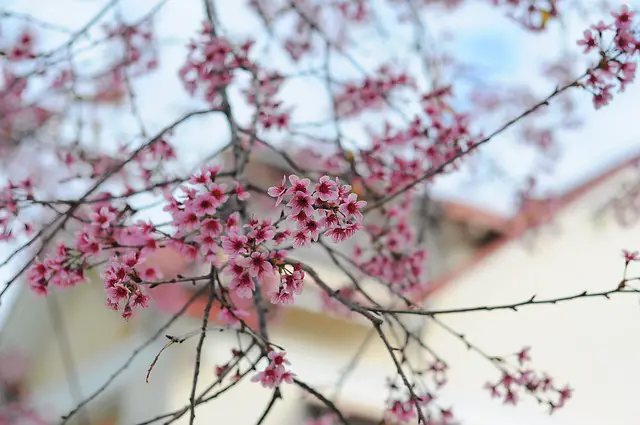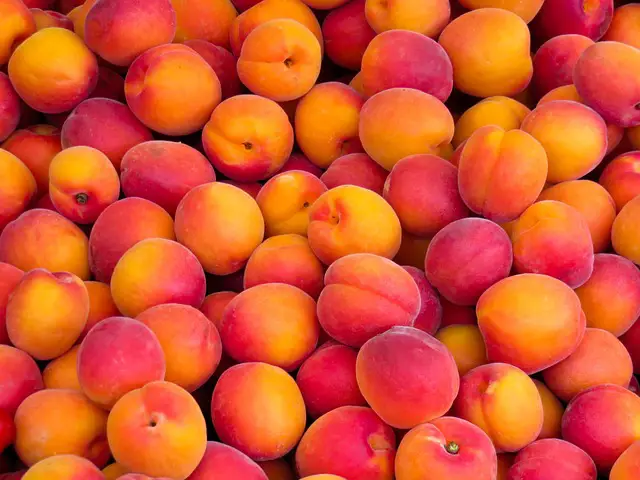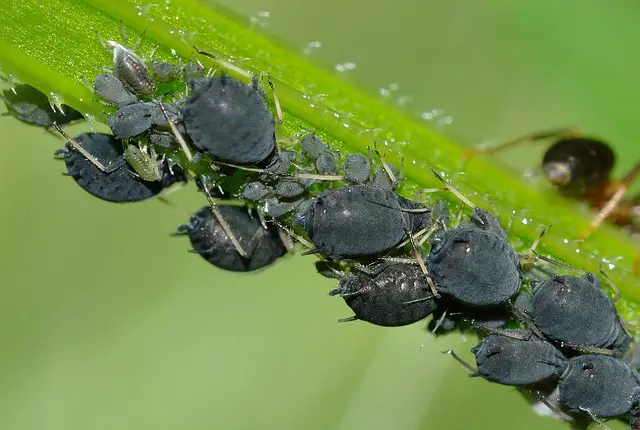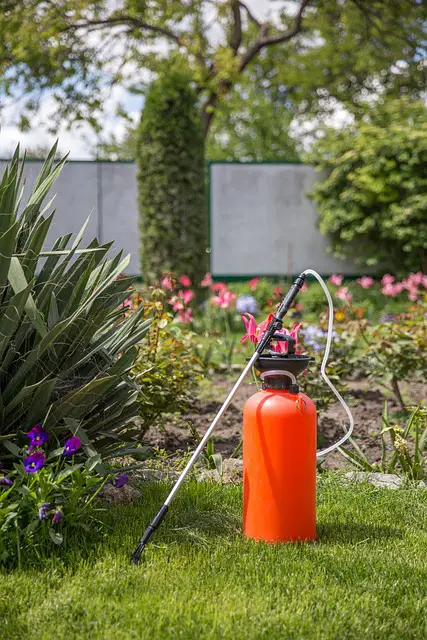
We may receive commissions from purchases made through links in this post, at no additional cost to you.
Eating home-grown, fresh-picked peaches is just about the only way to enjoy the fruit as nature intended it (those mealy, bland peaches at most grocery stores aren’t even worth buying, in my opinion). Unfortunately, peach trees take a good amount of maintenance to guarantee a decent harvest.
Peach trees are especially susceptible to pest and disease pressures. Among other things, such as regular pruning, keeping to a regular spray schedule is an essential part of managing these problems. And dormant spraying is the first step.
Spraying dormant peach trees is essential to prevent pest and disease problems during the growing season. Spray a copper fungicide to prevent peach leaf curl and other fungal diseases, and spray horticultural/dormant oil to prevent pests such as aphids, mites, and borers.
The dormant season for peach trees is also the dormant season for insects and pests. Dormant sprays suffocate larvae and prevent insect eggs from hatching. Fungicides sprayed at this time will also kill off fungal spores that may be overwintering on or near the peach tree.
In most locations, peach trees require some spraying throughout the growing season to manage pest and disease issues. Dormant spraying is the first, and arguably most important, step in this process. If you start the season spraying when the tree is dormant, you will have a head start in preventing major issues later on…which means a bigger and better crop of peaches.

When Should You Spray Dormant Peach Trees?
Dormancy starts in winter when the leaves fall off the tree, and ends at bud break in the spring when the tree pushes out new growth. The tree produces growth-inhibiting hormones that cause its metabolism and energy consumption to slow down, allowing it to survive the cold winter temperatures.
In general, the time to apply dormant sprays on peach trees is in the late winter or early spring, before bud break. The exact timing will vary depending on climate, disease and pest pressure, and the peach variety’s disease resistance.
If your peach trees have had severe pest or disease issues in the past, or if the disease pressure is high in your area because of heat and humidity (read this article for more tips on growing peaches in hot climates), a more thorough dormant spraying schedule may be necessary. Sprays could be applied soon after the leaves fall, and then once or twice more before bud break.
For example, spraying once with a fungicide after leaf drop – between late November in the north and January in the south – is essential for controlling the dreaded peach leaf curl. (Read Leaf Curl on Peach Trees: What It Is and How to Fix It to learn more about treating this fungus.) If the winter is particularly wet and muggy – the perfect situation for fungal infections to take hold – another spray might be necessary in early spring – mid/late February or March.
(Some sources recommend remembering these spray dates by tying them to holidays: once after Thanksgiving and again just before Valentine’s day. This can be a helpful reference for some, although for those of us living in the south it may be closer to Christmas and Groundhog Day! It’s a safer bet to just watch your tree for leaf fall and bud swell.)
It’s important to watch the weather before spraying. Do not apply dormant sprays when the temperature for the next couple of days drops below freezing. To be safe, spray peach trees only when the temperature is set to remain above 35° for at least a day or two.
Also avoid spraying right before rain or other precipitation is predicted. This allows the spray to have a chance to dry on the tree before being washed off or freezing overnight.
What to Spray On Dormant Peach Trees
The type of dormant spray you choose depends on the problems you are trying to prevent. The first step is to contact your local county Extension Service, or seek out their online resources, to learn about which peach diseases and pests are a problem in your area. You can also ask at a local garden center or talk to other local peach growers. Then you can target your spraying program to your specific situation.

Dormant sprays can be used to prevent pest problems, diseases, or both. Some of the common peach diseases include bacterial canker, brown rot, blight, and peach leaf curl. Peach pests include borers, scale insects, aphids, and mites.
Below we’ve listed some common dormant sprays and what they are used for. (Note: All of the recommended products are hopefully easy to find and are sold in smaller amounts, as is appropriate for a home garden with one or two peach trees. Always double check with your local county Cooperative Extension to see what sprays are recommended for your area).
Horticultural Oil
Also called superior oil, insecticidal oil, supreme oil, dormant oil, or narrow range oil. Horticultural oil is an umbrella term for naturally-derived mineral oil sprays that can be safely used for pest and disease management in the garden. Many of these oils are organic, but not all of them are, so check the label (it depends on how it was made and if there is anything else added).
Dormant oils work as pest prevention because they smother the eggs or larvae of insects before they have a chance to hatch. Some also help prevent fungal infections such as powdery mildew or rust. They are usually sold in a concentrated format that should be mixed with water before spraying. Always follow package instructions.
Bonide All Seasons Horticultural and Dormant Oil Spray
- Organic
- Pests: aphids, scale insects, mites, mealybugs, some moths
- Diseases: Powdery mildew, rust, black spot, sooty mold
- Can also be used during the growing season
Monterey Horticultural Oil
- Organic
- Pests: aphids, leaf miners, leafhoppers, spider mites, scales, whiteflies, mealybugs, and more
- Diseases: Powdery mildew, rust, black spot, sooty mold
- Can also be used during the growing season
Liquid Copper Fungicide
Spraying peach trees with a product containing copper will prevent peach leaf curl and other potentially devastating fungal diseases. The concentration of copper in the formula is measured by MCE percentage, or metallic copper equivalent.
In general, the higher the MCE, the more effective the product will be, although other factors can affect how well it works (such as coverage, additives, and the frequency of rain that can wash the spray off the tree). Copper fungicides available to consumers tend to be liquid products containing copper ammonium complex with about 8% MCE. Adding horticultural oil (at a ratio of 1% of the mixture) will increase the effectiveness of these sprays.
Only use a copper spray once per year, in the early winter after the leaves fall and the tree is dormant. You do not want to overdo copper-based sprays, as copper can build up in the soil or water runoff and can be harmful to some organisms in high concentrations. If peach leaf curl infections have been particularly bad in the past, apply once more in mid to late February or March, before bud break.
Monterey Liqui-Cop Copper Fungicide Spray
- Organic
- 8% MCE
- Diseases: Peach leaf curl, powdery mildew, downy mildew, black spot, rust, blight, and more
- Dormant spray
Bonide Copper Fungicide
- Organic
- 1.8% MCE
- Diseases: Peach leaf curl, powdery mildew, downy mildew, black spot, rust, and more
- Can also be used throughout growing season
A Bordeaux mixture, which is a combination of copper sulfate, hydrated lime, and water, is also effective at preventing peach leaf curl and other fungal diseases. It is considered more effective to mix the ingredients close to application, rather than using a pre-mixed option (which can be very hard to find).
Details about how to properly prepare and apply Bordeaux mixture are available online, including here from the University of California Integrated Pest Management Program.
How to Spray Dormant Peach Trees
General Tips
As mentioned above, start by talking to other local gardeners, garden centers, and your local Cooperative Extension Service to get the most applicable pest and disease management advice for your area. Visit this site to find your nearest Extension Office.

It also bears repeating that you should follow all instructions on product labels about the amount, frequency, and timing of application. Some products may recommend different concentrations for more severe pest or disease control, versus general prevention. Don’t combine sprays unless a product specifically mentions it’s safe to do so.
It’s important to note that dormant sprays may not be needed every year in every backyard orchard. Keep track of what happened the previous season to decide if preventative spraying is necessary. If you want to avoid the need for excessive spraying, choose peach cultivars that are disease resistant.
Annual moderate pruning is an essential part of peach tree disease and pest management. Cleaning up dead and diseased growth, at least, will go a long way to stop the spread of disease. Read A Simple Guide to Pruning Peach Trees for Maximum Harvest for details about how and why to prune your backyard peach trees.
Although most dormant sprays are not harmful to wildlife or beneficial insects, some nearby plants may be sensitive to dormant sprays (such as Japanese maples or smokebush). Be careful of wind direction when spraying to avoid overspray in an unwanted location.
Did we mention that these dormant oils can be a little smelly, too? Avoid standing downwind while spraying. Wear protective clothing to keep spray away from eyes, skin, and to avoid inhaling or swallowing.
Tools Needed
- compression pump sprayer
- hose/water
- gloves
- goggles or other eye protection
- mask
- long pants and long sleeves
- step ladder
- dormant spray products
Procedure
- Clean up fallen plant debris around the peach tree, such as leaves, rotten or mummified fruit, or sticks/twigs.
- Prepare dormant spray according to product label instructions.
- Starting from the top of the tree and working down, spray until all tree surfaces are completely saturated, to the point of dripping (unless otherwise stated in product instructions). Thorough coverage is essential for pest and disease prevention.
- Make sure to also spray the trunk and the area directly under the tree to kill any fungal spores, insect eggs or larvae, or other overwintering pests.
- If desired, mulch around the tree after spraying to prevent fungal spores from splashing onto the tree.

